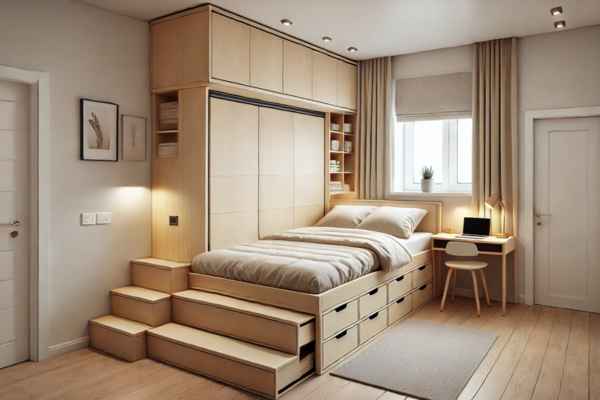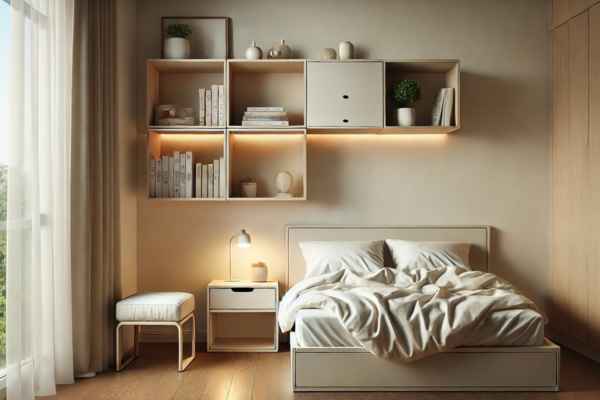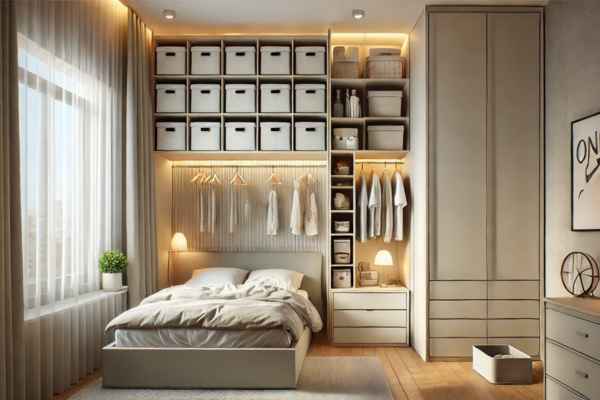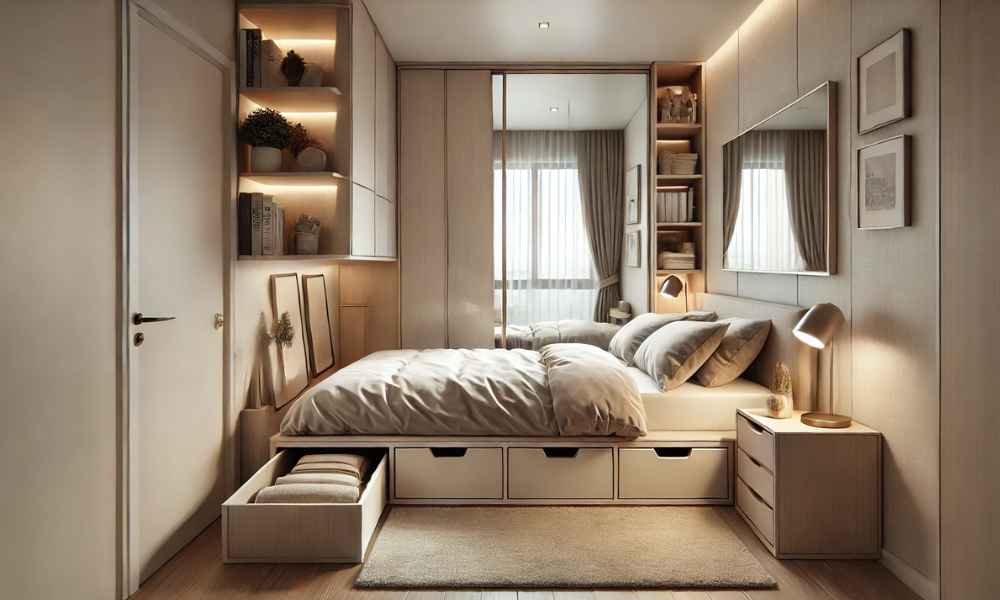A small bedroom presents both a challenge and an opportunity. While space constraints may seem limiting, thoughtful furniture arrangement can create an environment that feels both functional and inviting. The key lies in maximizing every square inch while maintaining an aesthetically pleasing and comfortable atmosphere. Strategic placement of furniture, utilization of vertical storage, and a minimalist approach can transform even the tiniest bedroom into a serene retreat. Whether you’re working with a compact urban apartment or a cozy guest room, this guide will walk you through the best techniques to arrange furniture efficiently in a small bedroom.
Understanding Your Space: The Key to a Well-Organized Small Bedroom
Before deciding where to place furniture, take a moment to analyze the space. Measure the room’s dimensions and note the location of doors, windows, and built-in features such as closets or alcoves. The goal is to create a functional layout that allows for seamless movement while avoiding clutter. Consider how you use your bedroom. Do you need a workspace? Do you prefer a minimalist design or require ample storage? Answering these questions will help determine the ideal furniture arrangement. In a bedroom, every decision must be intentional—each piece of furniture should serve a purpose and complement the overall layout.
The Power of Minimalism: Less Furniture, More Functionality
In a small bedroom, less is truly more. A cluttered space can feel overwhelming, reducing both comfort and usability. Minimalism isn’t about deprivation; it’s about curating a space that fosters tranquility and efficiency. Opt for multi-functional furniture, such as a bed with built-in storage drawers or a fold-out desk that can double as a nightstand. Limit decorative pieces to a few carefully selected items that enhance the ambiance without overwhelming the room. Thoughtfully chosen textures, neutral colors, and simple decor can create a sense of spaciousness. Decluttering is an ongoing process. Regularly evaluate what you truly need and remove excess items to maintain an open, airy feel. A minimalist approach ensures that your bedroom remains a restful and visually appealing sanctuary.
Choosing the Right Bed: Maximizing Comfort Without Sacrificing Space

The bed is the focal point of any bedroom, but in a small space, it must be chosen and positioned with precision. Opt for a bed size that provides comfort without dominating the room—twin, full, or even a space-saving Murphy bed can be excellent choices.
Optimal Bed Placement
- Against the longest wall for a balanced look.
- In a corner to maximize floor space.
- Centered with symmetrical nightstands for a traditional layout.
Space-Saving Bed Options
- Storage Beds: Built-in drawers provide extra space for linens and clothing.
- Murphy Beds: Fold into the wall when not in use, freeing up valuable space.
- Loft Beds: Elevate the bed to create storage or workspace underneath.
Selecting the right bed and placing it strategically can dramatically improve the flow and functionality of a small bedroom.
Nightstands That Work: Finding the Perfect Fit for Tight Spaces

Traditional nightstands can be bulky, making them impractical for bedrooms. Instead, consider compact alternatives that provide function without consuming excess space.
Space-Saving Nightstand Ideas
- Floating Shelves: Mounted to the wall, freeing up floor space.
- Slimline Nightstands: Narrow tables that fit beside the bed without obstructing movement.
- Multi-Use Pieces: Small dressers or stools that double as nightstands.
Choosing a space-efficient nightstand keeps essentials within reach while maintaining an open and uncluttered feel.
Dressers and Storage Solutions: Maximizing Vertical and Hidden Space

When floor space is limited, vertical storage becomes essential. Dressers should be selected based on height rather than width, allowing for maximum storage without consuming too much room.
Smart Storage Strategies
- Tall, Slim Dressers: Utilize vertical space while maintaining a small footprint.
- Wall-Mounted Shelving: Adds storage without taking up valuable floor space.
- Under-Bed Storage: Roll-out drawers or storage bins keep belongings out of sight but easily accessible.
By thinking vertically and utilizing hidden storage options, you can maintain a tidy and organized bedroom without sacrificing valuable living space.
Smart Closet Organization: Making the Most of a Tiny Wardrobe Space

Closet space in bedrooms is often limited, but with strategic organization, it can be maximized to its full potential.
Closet Optimization Tips
- Double Hanging Rods: Double the amount of hanging space for clothing.
- Slim, Non-Slip Hangers: Create more room by eliminating bulky hangers.
- Over-the-Door Organizers: Utilize unused space for shoes, accessories, or toiletries.
Implementing these smart closet solutions ensures that every inch of storage is used efficiently while maintaining an organized and accessible wardrobe.
Using Multi-Functional Furniture to Save Space and Stay Organized
In a small bedroom, every piece of furniture should work harder. Multi-functional furniture is a game-changer, allowing you to maximize space without sacrificing style or comfort. Consider beds with built-in storage drawers or hydraulic lift-up frames that provide hidden storage underneath. A fold-out desk that doubles as a nightstand can help create a compact workspace without cluttering the room. Ottomans with hidden compartments can serve as seating while also offering a place to store extra blankets or books. Another clever option is a loft bed, which frees up valuable floor space by raising the sleeping area and creating room underneath for a desk, a reading nook, or additional storage. Murphy beds, which fold into the wall when not in use, are perfect for truly compact spaces. When every item has multiple uses, you maintain organization while ensuring the room feels open and functional.
The Art of Layout: Small Bedroom Floor Plan Ideas That Work
Arranging furniture in a small bedroom requires a strategic approach to make the space feel comfortable and uncluttered. Start by placing the bed first, as it’s the largest piece of furniture and the focal point of the room. Positioning the bed against the longest wall or in a corner can create an open feel while maximizing floor space.
For a balanced and airy layout, consider these approaches:
- The One-Wall Layout: Placing all large furniture along a single wall creates an open flow and easy movement.
- The Corner Arrangement: Pushing the bed into a corner can free up space in the center of the room, making it feel larger.
- The Symmetrical Setup: Placing nightstands on either side of the bed, along with a dresser or desk opposite, can create a balanced aesthetic.
Avoid blocking windows with large furniture pieces, as natural light enhances openness. If space allows, opt for wall-mounted shelves instead of bulky bookcases to free up the floor while still offering storage. A carefully planned layout ensures that every inch of your bedroom is used efficiently.
Lighting and Mirrors: Making a Small Bedroom Feel Bigger and Brighter
Proper lighting and mirror placement can dramatically transform the perception of space in a small bedroom. Bright, well-distributed lighting prevents the room from feeling enclosed. Instead of relying solely on overhead fixtures, layer your lighting with a combination of wall sconces, bedside lamps, and string lights to create a warm, inviting ambiance. Mirrors are one of the most effective tools for visually enlarging a room. A large mirror placed opposite a window reflects natural light, making the space feel more open and airy. Mirrored closet doors or a full-length mirror leaning against the wall can further enhance the illusion of depth. If you’re short on wall space, consider mirrored furniture or decorative wall mirrors that double as art pieces. These small yet powerful adjustments make the bedroom feel more expansive and less confined.
Decor Tips That Enhance the Flow of a Small Bedroom
Decor choices can significantly impact how spacious and cohesive a small bedroom feels. Opt for a light, neutral color palette to create an airy atmosphere—soft whites, beiges, and pastels can make the room appear larger. To add warmth and personality, incorporate textures through bedding, area rugs, and throw pillows while keeping patterns minimal to avoid visual clutter. Wall-mounted shelves or pegboards provide functional decor without taking up valuable space. Instead of heavy drapes, choose sheer curtains that allow natural light to filter through, further enhancing the sense of openness. Keeping the floor as clear as possible by using elevated furniture or hidden storage solutions also contributes to an unobstructed and harmonious flow.
Avoiding Common Mistakes When Arranging Furniture in a Small Bedroom
One of the biggest mistakes in small bedroom design is overfilling the space with oversized or unnecessary furniture. A large bed or bulky dresser may seem tempting, but it can quickly overwhelm the room, leaving little room to move around. Instead, opt for appropriately sized furniture that serves multiple purposes. Another common error is ignoring vertical space. Many people focus solely on floor area, forgetting that walls offer valuable storage opportunities. Floating shelves, wall-mounted desks, and tall dressers can help maximize storage without sacrificing floor space. Blocking natural light is another design misstep. Placing furniture in front of windows can make a bedroom feel even more enclosed. Keeping pathways clear and arranging furniture to allow natural light to flow freely will instantly make the space feel more open.
Final Touches: Making Your Small Bedroom Feel Cozy and Inviting
A small bedroom doesn’t have to feel sterile or cramped—it can be a warm, inviting space with the right finishing touches. Layered lighting plays a crucial role in setting the mood. Use soft bedside lamps, fairy lights, or LED strip lighting to create a relaxing ambiance. Textures also enhance coziness. Adding plush bedding, a soft rug, or woven throw pillows brings depth and warmth to the space. Instead of cluttering surfaces with too many decor items, opt for a few well-placed personal touches, such as framed photos, a favorite piece of artwork, or a small indoor plant. Scent is another element that contributes to coziness. A calming candle, essential oil diffuser, or fresh flowers can make a bedroom feel even more inviting. The goal is to create a balanced environment where functionality meets comfort.
What’s the Best Way to Make a Small Bedroom Look Bigger?
A well-designed small bedroom can feel significantly more spacious with the right visual tricks. Light, neutral colors such as white, beige, or soft pastels reflect light and create the illusion of a larger space. Keeping furniture low-profile and streamlined also helps maintain an open feel. Mirrors are one of the best tools for making a room appear larger. Placing a large mirror opposite a window will reflect natural light and add depth to the space. Glossy or reflective furniture pieces can achieve a similar effect, enhancing brightness and openness. Keeping decor minimal and avoiding heavy, dark-colored drapes allows light to flow freely. Instead, opt for sheer curtains that maximize natural brightness while maintaining privacy. A well-organized, clutter-free room always feels bigger than one overloaded with furniture and decorative elements.
How Can I Fit a Desk Into a Small Bedroom Without Making It Feel Cramped?
A desk is essential for many people, whether for work, study, or creative projects, but fitting one into a small bedroom can be challenging. The key is choosing a compact and space-efficient design. Wall-mounted or floating desks provide a workspace without taking up valuable floor space. A foldable desk can be stored away when not in use, freeing up room for other activities. Another clever option is a desk that doubles as a nightstand, allowing one piece of furniture to serve two purposes. Positioning the desk near a window can make the area feel more open while providing natural light for work. Pairing it with a sleek chair that can be tucked away under the desk or a transparent acrylic chair keeps the room feeling light and airy. By selecting the right desk and placement, you can create a functional workspace without overwhelming your small bedroom.
What Are the Best Storage Hacks for Tiny Bedrooms?
Storage is one of the biggest challenges in a small bedroom, but with the right hacks, you can make the most of every inch. Under-bed storage is a must—whether through built-in drawers, storage bins, or vacuum-sealed bags for off-season clothing.Wall space should also be maximized. Floating shelves, pegboards, or wall-mounted organizers can hold books, decor, or everyday essentials without taking up floor space. Hanging organizers on the back of doors provide extra storage for shoes, accessories, or toiletries. Dual-purpose furniture is another lifesaver. A storage ottoman, a bed with built-in drawers, or a fold-out desk helps keep clutter at bay while maintaining a streamlined look. The secret to maximizing storage in a small bedroom is finding solutions that blend seamlessly into the design, keeping the space tidy and functional.
Conclusion
Arranging furniture in a small bedroom may seem daunting, but with a strategic approach, it can become an opportunity to create a cozy, stylish, and efficient space. By avoiding common mistakes, choosing multi-functional furniture, incorporating storage hacks, and using design techniques to enhance openness, you can make a compact room feel spacious and inviting. Whether it’s through smart layouts, lighting tricks, or space-saving solutions, a well-organized small bedroom proves that limited square footage doesn’t mean compromising on comfort or style.
